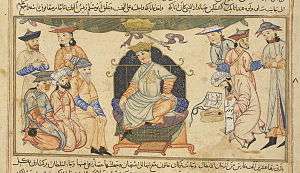Barkiyaruq
| Barkiyaruq | |
|---|---|
|
Artwork of Barkiyaruq | |
| Sultan of the Great Seljuq Empire | |
| Reign | 1092–1105 |
| Predecessor | Mahmud I |
| Successor | Malik-Shah II |
| Born | 1079/1080 |
| Died |
1105 (aged 25) Borujerd |
| Issue | Malik-Shah II |
| House | House of Seljuq |
| Father | Malik-Shah I |
| Religion | Sunni Islam |
Abu al-Muzaffar Rukn ud-Din Barkyaruq ibn Malikshah (Persian: ابو المظفر رکن الدین رکن الدین برکیارق بن ملکشاه), better known as Barkyaruq. The Turkic word Berk Yaruq means (firm, unwavering light),[1] was the sultan of the Great Seljuq empire from 1092 to 1105.
Early life
Barkiyaruq was born in 1079/1080,[2] the oldest son of Malik Shah I[3] and a Seljuq princess. He had five brothers; Mahmud I, Ahmed Sanjar, Mehmed I, Dawud, and Ahmad.
During his youth, the succession to the Seljuq sultanate was complicated by the death of two of his half-brothers: Dawud (died 1082) and Ahmad (died 1088), whom both were sons of the Kara-Khanid Princess Turkan Khatun, she also had a son named Mahmud (born 1087) which she wanted to succeed his father, while the vizier Nizam al-Mulk and most of the Seljuq army was in favor of Barkiyaruq.[4] Turkan Khatun then allied with Taj al-Mulk Abu'l Ghana'im to try to remove Nizam from his post. Nizam was assassinated in 1092, which made Barkiyaruq lose a powerful supporter. Barkiyaruq's father eventually died some months later. Turkhan Khatun then took the opportunity of his death, and with the support of Taj al-Mulk, put her 4 year old son, Mahmud I, on the throne, while Barkiyaruq was proclaimed as Sultan of the Seljuq Empire at Ray by the faction of the late vizier Nizam al-Mulk.
Reign
However, Mahmud I was not the only Seljuq claimant to the throne, several other Seljuq princes such as Arslan-Argun, Mehmed I, and Tutush I, also claimed the throne.[5] Taj al-Mulk was later assassinated by the ghulams of Nizam al-Mulk,[6] while Turkhan Khatun and her son Mahmud I died in 1094. One year later, Barkiyaruq clashed with Tutush I at Ray, where Barkiyaruq managed to emerge victorious and kill Tutush I along with his supporter Ali ibn Faramurz.[7]
In 1105, Barkiyaruq died in Borujerd, and was succeeded by his son Malik Shah II. It has been reported that his body was returned to Isfahan. However, some people say his tomb is in 5 km north of Borujerd, where today is a historical monument called Zavvarian.
Affairs of the Empire during his reign
During Barkiyaruq's short reign, he had five viziers, three of them were the children of Nizam al-Mulk; Izz al-Mulk Husain, Mu'ayyid al-Mulk and Fakhr al-Mulk.[8] The two other viziers were Abd-al-Dihistani Jalil and Khatir al-Mulk Abu Mansur Maybudi. During his reign, Barkiyaruq's mostly focused on a way to find money to keep the expenses of the state.
References
- ↑ Notes on Some Turkish Names in Abu 'l-Faḍl Bayhaqī's Tārīkh-i Masʿūdī, C.E.Bosworth, Oriens, Vol. 36, (2001), 305.
- ↑ Bosworth 1968, pp. 220-221.
- ↑ E. J. Van Donzel, Islamic Desk Reference, (E.J.Brill, 1994), 464.
- ↑ Bosworth 1968, pp. 68-80.
- ↑ Bernard Lewis, The Assassins: A Radical Sect in Islam, (Basic Books Inc., 2003), 51.
- ↑ Bosworth 1968, p. 57.
- ↑ Bosworth 1968, p. 38.
- ↑ The Political and Dynastic History of the Iranian World (AD 1000-1217), C.E. Bosworth, The Cambridge History of Iran:The Saljuq and Mongol Periods, Vol. 5, ed. J.A. Boyle, (Cambridge University Press, 1968), 105.
Sources
- Bosworth, C. E. (1968). "The Political and Dynastic History of the Iranian World (A.D. 1000–1217)". In Frye, R. N. The Cambridge History of Iran, Volume 5: The Saljuq and Mongol periods. Cambridge: Cambridge University Press. pp. 1–202. ISBN 0-521-06936-X.
| Preceded by Mahmud I of Great Seljuk |
Sultan of Seljuq Empire 1092–1105 |
Succeeded by Malik Shah II |
